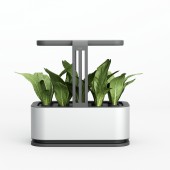DESIGN NAME:
Smart Garden
PRIMARY FUNCTION:
Hydrophoni̇c Growing System
INSPIRATION:
Smart Garden’s design philosophy is deeply intertwined with the seamless integration of technology and nature. Through our HydroHome Series, we endeavor to strike a perfect balance between cutting-edge functionality and environmental stewardship. Our mission is to revolutionize home gardening, creating a verdant sanctuary that blends the serenity of green spaces with the convenience of technology-enhanced care. We are committed to promoting a sustainable and delightful lifestyle for everyone.
UNIQUE PROPERTIES / PROJECT DESCRIPTION:
-Proprietary hydroponic technology for superior plant growth.
-Sustainable materials and operations that prioritize energy conservation.
-Intuitive interface welcoming both novice and expert gardeners alike.
-Space-saving build ideal for urban living conditions.
-Bluetooth feature for music playback, creating a soothing environment.
-Wireless charging station, adding to the utility and modernity of the system.
OPERATION / FLOW / INTERACTION:
Imagine a system where your plants’ needs are communicated clearly and maintenance doesn’t disrupt their growth. The Smart Garden features a water-level sensor that signals when it’s time to replenish, indicated by a distinct LED alert. When you slide the unit to the right, beneath the sturdy aluminum frame, only the water tank is detached, preserving the delicate roots of your plants. Refill or replace the tank with ease, assured that the thriving ecosystem within your Smart Garden remains untouched and intact. With intelligent automation at its core, the Smart Garden consistently monitors water levels, providing timely notifications when attention is needed. This preemptive communication ensures that the plants always have adequate hydration and that the system operates within safe parameters to protect its components. Pairing with the “SmartGarden” via Bluetooth, you can elevate your gardening sessions with your choice of music. The unit’s speakers are a conduit for your personal playlist, enriching the atmosphere as you tend to your plants. Additionally, through a user-friendly app, you can control light settings, adjusting the intensity to emulate the natural ebb and flow of daylight, creating an optimal growing environment for your indoor garden.
PROJECT DURATION AND LOCATION:
1 year Turkey
FITS BEST INTO CATEGORY:
Home Appliances Design
|
PRODUCTION / REALIZATION TECHNOLOGY:
Plastic injection and thermoform used for plastic forming and Aluminum CNC bending and laser welding used for the metal case.
SPECIFICATIONS / TECHNICAL PROPERTIES:
234 mm x 394 mm x 413 mm
TAGS:
sustainable design, hydroponic gardening, smart home technology, user experience, iterative design process, eco-friendly materials, functional aesthetics, design innovation
RESEARCH ABSTRACT:
Design is storytelling with materials, colors, and shapes—each creation a narrative, every product a tale waiting to unfold. The genesis of a design, often as humble as a sketch, whispers the possibility of something new. These initial strokes are the first words of a story that will materialize in the physical world. The journey from concept to reality is fraught with challenges, revealing the designer's essence through a path of discovery. Each iteration brings us closer to an embodiment of purpose and beauty.
In crafting the Smart Garden, understanding the dialogue between user and product became our cornerstone. It began with immersing ourselves in the lives of potential users, creating personas not as mere demographic profiles but as characters in a larger narrative of sustainability, health, and harmony with nature. These personas guided the evolution of "Smart Garden" with their experiences and feedback.
Mood boards captured the essence of our vision, serving as a dynamic backdrop that evolved with our understanding. This visual language bridged the abstract and the tangible, facilitating communication with our team and the broader community. The sketching phase was an exploration, where each line and erasure offered new possibilities. The magic, however, began with prototyping. Ideas took on a physical form, with each prototype a hypothesis to be tested for functionality, ergonomics, and aesthetics.
Feedback from prototypes was invaluable, helping to refine our design through a process of co-creation. This iterative cycle from sketch to prototype to feedback was crucial in forging Smart Garden. The transition to digital modeling with Alias and rendering with Maya introduced a new level of precision. Here, the design was not just visualized but experienced, allowing us to explore forms and functions previously unimaginable.
Manufacturing the prototype was a convergence of art and engineering. 3D printing and aluminum bending transformed digital models into tangible artifacts. Collaboration with experts in Sweden ensured the product's intelligence matched its beauty. This journey from idea to prototype wasn't just about creating a product but about embodying a design philosophy that values empathy, sustainability, and innovation.
CHALLENGE:
Designing the Smart Garden was akin to navigating a labyrinth, where each decision played a pivotal yet distinct role. This journey, especially for a concept as intricate as the Smart Garden, was like conducting an orchestra to achieve harmony between form, function, and sustainability. The challenge lay in balancing aesthetic appeal with functional efficacy. The Smart Garden wasn't just envisioned as a hydroponic system but as a piece of living art, enhancing the spaces it occupies. This dual identity demanded a sophisticated design language that accommodated complex mechanisms efficiently.
Striking this balance required a dance between simplicity and complexity, ensuring every design element served both aesthetic and functional purposes. Placing the user at the heart of the design process introduced intricacies. We aimed not just to create a product but to cultivate an experience that resonates personally with a diverse audience. This required empathetic design, delving into the lives and desires of potential users to translate abstract needs into tangible design elements.
Incorporating sustainability presented both a challenge and an opportunity. Selecting environmentally friendly materials and processes while maintaining durability and aesthetic appeal necessitated rigorous research and creativity. It underscored our commitment to designing not just for the present but for a future harmonizing human creations with the natural world.
Orchestrating these elements into a cohesive whole was perhaps the most challenging aspect. It involved finding a unified voice amid competing priorities, a voice that championed innovation, beauty, and responsibility. This cyclical process, characterized by iterative refinements, sometimes felt like steps backward but were essential for forward momentum.
The realization of the Smart Garden as a tangible product was a moment of profound satisfaction, though the journey was marked by doubt and frustration. There were days when the balance we sought seemed just out of reach, and the vision appeared too ambitious. It was perseverance, fueled by a belief in our creation's value, that propelled us forward.
In retrospect, the hardest part wasn't a specific technical challenge or a particular user need but the act of creation itself—the relentless pursuit of perfection, the constant balancing of ideals and practicalities, and the courage to reimagine the product's potential. The Smart Garden stands as a testament to this journey, symbolizing the achievements possible when we dare to dream, challenge, and create. Through these challenges, the essence of design was revealed not as a series of obstacles but as opportunities to innovate and truly understand what it means to introduce a new product—one that intersects art, technology, and human experience.
ADDED DATE:
2024-01-27 10:20:34
TEAM MEMBERS (1) :
IMAGE CREDITS:
Onur Yusuf Dastan, 2023.
PATENTS/COPYRIGHTS:
2023 014038
|









